
For some years now, progress has been made towards a national agreement to improve the quality of the city and housing, both at the commercial and state level. There is a cross-cutting agreement on the crisis facing the country on housing and some basic principles have generated agreement in broad sectors of society. This year the Ministry of Housing and Urbanism convened the National Dialogue for Housing and the City, an instance to resolve the crisis facing the sector.
In a market-oriented housing production system, the mix between greed and lax regulation can lead to some unwanted effects, such as low-quality commercial housing. The nanodepartments are studios that have between 15 and 21 m2, rooms that result from a financial interpretation of the house as an object of rent rather than as a living space. This is problematic and the norm covers this type of deformations of residential architecture. The nanodepartment is far from setting up a space for a life project.
In this context, it is important to make a difference between the minimalism of these residential microtypologies. The great reference of minimalism is Mies Van Der Rohe, who designed studio apartments on Lake Shore Drive, whose measures were 64,025 m2, the style was a choice of interior use of furniture, mainly, and did not refer to a ridiculously narrow spatiality.
The General Ordinance of Urbanism and Constructions allows apartments of up to 15 m2 to be considered as habitable, however, the World Health Organization says that the minimum space per person is 20.7 m2. In this way, an apartment of 17 m2 complies with the very relaxed Chilean technical standard, but not with international standards.
A few weeks ago a group of constituents entered a proposal for the right to housing. In this sense, it is essential that the new constitutional document is based, at least, on the international standards enshrined in agreements signed by the State of Chile, which avoid this type of residential deformations to move towards architectural models where space, light and the material quality of housing deliver dignity to those who inhabit them.
That the good quality of housing space is a constitutional principle can be a way to improve the lives of all.
The content expressed in this opinion column is the sole responsibility of its author, and does not necessarily reflect the editorial line or position of El Mostrador.
"El reclamo puede ser genuino, pero construido sobre una mentira", apuntó el presidente Javier Milei…
El gobernador de la provincia de Buenos Aires, Axel Kicillof, encabezó un acto en Ensenada…
El diputado nacional de La Libertad Avanza, José Luis Espert, expresó su confianza en la…
Tras la masiva reaparición de Cristina Fernández de Kirchner, el presidente Javier Milei apuntó contra…
El principal propósito de la nueva comisión es evaluar los recursos humanos en el Senado,…
En una medida que busca redefinir las condiciones de los seguros de automóviles en Argentina,…
Esta web usa cookies.